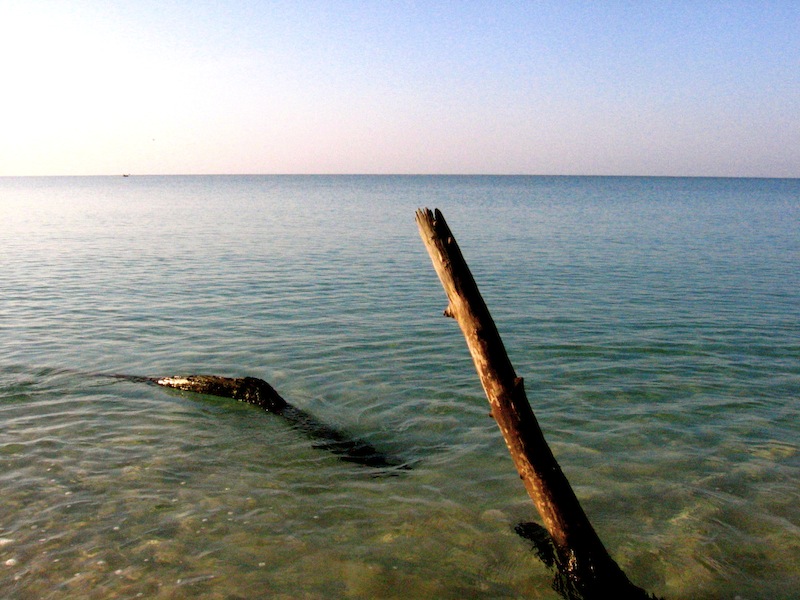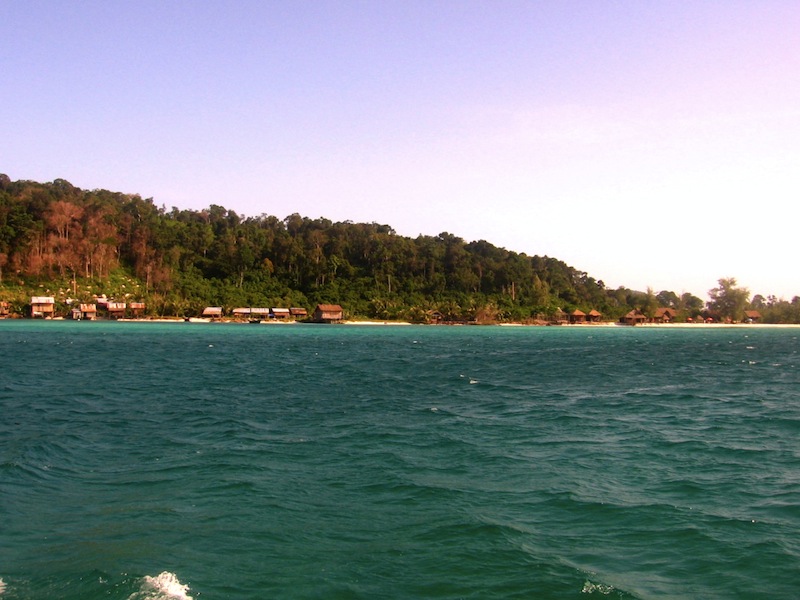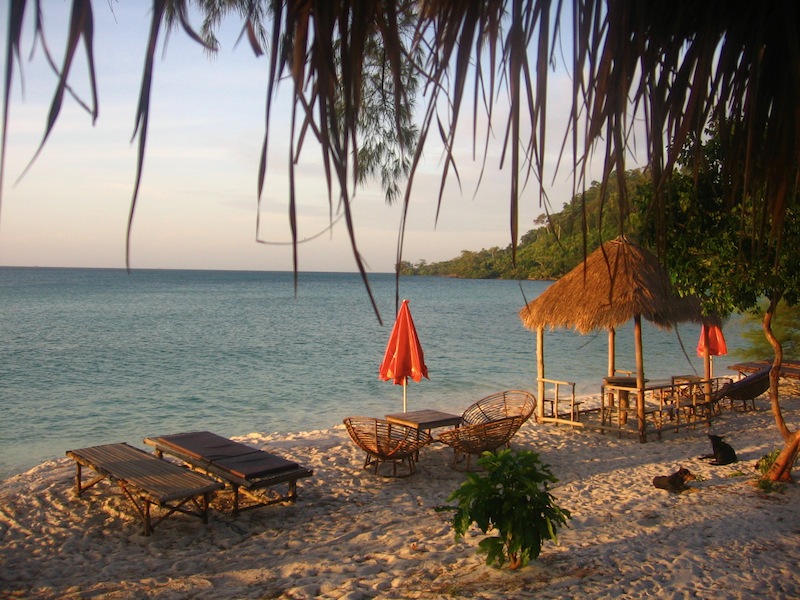The Waves of Koh Rong Island
Often as we go back and forth through the mundane in our lives, protected by the gods of gadgets and the constructed realities of society, the randomness of nature appears like a distant dream, a spiderweb’s touch long forgotten. Whenever we find ourselves once again lost within the natural, it is common for the constructions of ourselves to start peeling off like an old skin, revealing whatever rawness still resides in our minds. Also, it brings back a sense of wonder.
The moon is there. We see it. We expect it. We have touched it.
The sea is there. We smell it. We dwell in it. We have grown accustomed to it, it looks great on postcards – are we not envious of all those images of yachts cruising along a pristine foamy blue? For many in our world, the sea is also summer. With summer comes memory, and memory can be tricky.
A full moon is beautiful to look at. When combined with the sea, it is also a force of extravagant power.

We were in Cambodia. Idling by the sea in Sihanoukville after the wonders of Angkor Wat and the Temples of Siem Reap, and perceiving how far human hubris had pushed the shoreline until it was virtually non-existent, a decision was made to go back to basics. No more comforts of air conditioned sleep, semi-paved roads and drunken, sunburned crowds.
A discovery was made of an island in the Gulf of Thailand. Its name was Koh Rong, and gathered information made reference only of a fishing village and some beach huts catering to the occasional tourist. Its selling point was the solace of a desert island, but with toilets. A decision was taken to accept this offer. After a two hour boat trip through calm waters, we descended upon the west side of Koh Rong island, on a quiet bay surrounded by forest.

We were greeted by palm trees and the fishermen with their families, accompanied by the barking of skimpy dogs, busy smelling the newly arrived strangers. The Koh Rong beach bungalows were planted a few meters away from the water and offered a roof, a mattress equipped with nets and a small toilet at the back. There were some initial groans from some members of our small group at the unsophisticated accommodation presented before us, but soon everyone was sorted into their own huts, the initial apprehension giving way to dealing with the practicalities of being in an almost unspoiled island lacking in most modern comforts.

Our luxurious hut (with verandah!)
Electricity was shut down very day after 7 pm. Food was bought from the villagers and worth every penny. It comprised mostly of fruit and fish – all the island and its waters could provide. There was nothing to do but sit, swim, read, walk and gaze. An hour stretched into a full day, a day seemed like a week. All was full of peace and the husky smell of distance.

The night previous to our return was graced by a limpid full moon. Lying in the hut at night, the rising wind burst through every crack of the ramshackle planks lifting us from the sand. The noise was unrelenting. Early in the morning, we gathered our belongings and came out into the beach, immediately noticing the agitated sea. One had the sense of something brewing underneath and beyond the sheltering bay. It was only when already on the boat, sitting on the open deck, waving goodbye to the villagers and to the island, that a lost memory struck: spring tide.

As the boat began to leave the bay and gently sway, making everyone giggle at each other, I sat at the bow, looking at the captain’s cabin. As we left the bay, the sea turned rougher, and the giggles began to subside, replaced by some frowns and worried glances toward the horizon. In order to get to the island and back to Sihanoukville, we had to pass a strait between Koh Rong and its sister island, Koh Rong Samloem.
The first voyage had been uneventful, but approaching the strait the sea, so calm and shimmering only days before, was now turning into a powerful, relentless force. When we hit the first big wave, and the boat went up in the air for a few seconds, only to crash with a loud bang in the now restless surface of the sea, one could feel panic starting to mount on deck. After the third and fifth crash, everyone was drenched to their bones.
I was still sitting at the bow and holding the anchor’s rope with my right hand, looking at the captain’s cabin and watching his expression change and turn somber. He was, like everyone else from the island, a dark and beautiful human being, looking no older than 25. As his eyes narrowed, my right hand clutched the rope harder. The boat kept trudging diagonally against the waves. If one would hit straight, we could capsize. As I was letting my mind conjecture on the practicalities of being in the middle of a storm at sea, I heard something truly scary… silence.
The engine had stopped. For one single, thunderous second, all was silent but the wind and the waves, and one felt at the verge of the end of the world. Then, it hit. Huge, loud, mad, paramount.
One wave came rolling down deck, washing us all in salted water and fury. The engines restarted immediately, and the captain urged everyone into the minute cabin. I tried my luck staying put, at the bow, finding some strange comfort in the illusion of freedom. One could hear the people in the cabin throwing up, and some moved to the stern to better get rid of everything they had eaten for the past week. All on deck were holding on to a rope and had begun the long journey to their own private “happy place”. I kept glancing at the captain, while constantly turning my head to see what was coming.
At this point, we had made 10 minutes into the strait. We had been through a mere introduction. Shore could be seen from both sides of the boat, a luscious green of jungle, but we could have been looking at the stars. As we passed through the strait, after having been rocked, drenched and beaten for what seemed like an eternity, I thought of the likelihood of drowning in the Gulf of Thailand.
Although the waves were warm, the wind seemed to be blowing straight from a polar bear’s mouth. I was constantly soaked, and had begun to shiver like a manic from the cold, while still having to use all my might to grab hold of the rope and not be thrown overboard. The physical and emotional strain reached a level of violence where mortality loses its context. We just wanted it to stop. Have you ever been in a maddeningly painful place with no way out? No, much worse than high school. The feeling was one of utter helplessness, of total and absolute loss of control – limbo in a maelstrom.
Every time the engine stopped, which it did very often, we would hold our breath and wonder “Will this be the one?”. And then the engine would start again, and we would realize how extremely tired we were. After a few hours, this situation starts to do weird things to one’s mind. I kept peeking at the captain, which had the more focused expression I have ever seen on anyone. Those eyes would make Kasparov break down in a sweat. He had to count 5 waves ahead, coming from all sides. He did a magnificent job, and most likely saved our lives. Nevertheless, what stuck was the randomness of it all, the sheer power engulfing us, reminding us that we were alive on a mere technicality.
For all the incredible work the captain did, he could only deal with one wave at a time; more, and there was nothing anyone could have done. Just as we were leaving the strait, the engine stopped one more time. As before, the boat went up, but now I saw the captain on a nearly vertical level, and held on for the imminent crash into a 16 foot void. But it never came.
Another wave hit us straight, and for one second we seemed to be underwater. It was only then I knew with full certainty we were alive on a whim. As the wave washed over the entire boat and we surfaced once again, only to be hit by another wave soon afterward, but still far in between enough for the boat to still be afloat, I realized neither the captain nor anyone else could save us from the swirling waters if the wind blew just a bit harder on the sea’s surface.

Last photo before the storm
The violence of Cambodia’s past is nowadays mostly a tourist trap. Repeatedly screening The Killing Fields from dawn to evening in hotel lobbies seems more quaint than horrific. Friendly calls to visit Choeung Ek from restless tuk-tuk drivers are heard throughout the streets of Phnom Penh, its impact no more unnerving than an invitation to visit the Eiffel Tower.
However, the landscape itself is still far from docile. There are fewer landmines, but the monsoon continues to batter its fields every season, bringing deluge and disarming thunder, although also renewing the aquatic life of the Tonle Sap. The sun and the moon are still at play, their cycles ruling the waves and most of its people, hanging on to the hope of a better future for their children.
As for Koh Rong island, the human desire to tame the wild has begun to exert its strength. One of the few places on Earth where one could still catch a glimpse of what Joseph Banks found in Tahiti centuries ago is now open for development, or whatever you might call it.




What a story! Glad everything turned out to be ok!
Yeah, that was one for the books – or, in this case, the silly blog. I’ll admit we were left a bit traumatized. Even now, we think twice before boarding a boat, or a ferry (or a floating log). Ironically, we keep being drawn to islands, and so must relive the trauma at least once a year. We’re not very bright people 🙂 Thank you for stopping by and safe travels!
I had a maritime mishap leaving Koh Rong as well. Maybe it’s the place to have them 🙂 Mine was a little different than yours but put the frak up some people that’s for sure. http://flattiresandslowboats.com/2013/12/21/stranded-at-sea/
Hey Tim! Guess Koh Rong is the Bermuda Triangle of SE Asia… Oh well, at least we’re alive to tell the tales, right? 🙂 Safe travels!